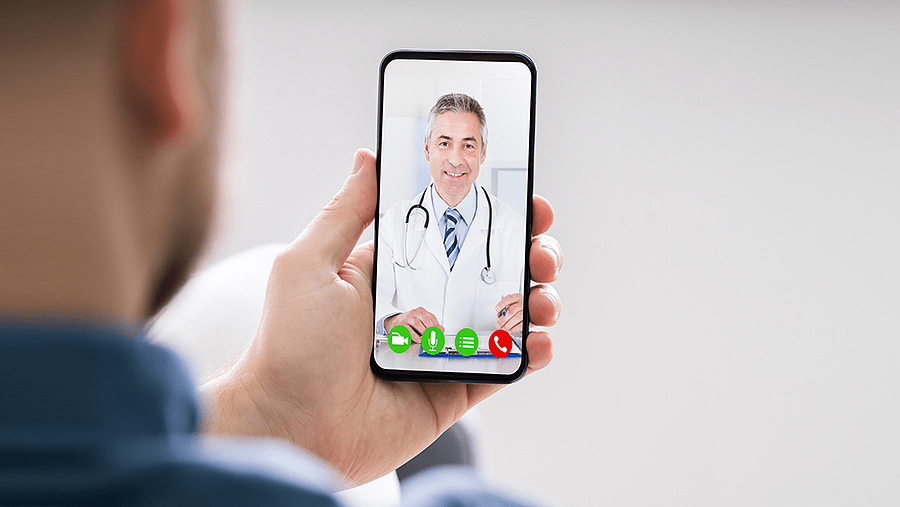The Role of Technology in Psychotherapy

Psychotherapy, aka talk therapy, is exactly that. One can go to a psychotherapist and “talk” through their mental illnesses and seek solutions for their problems in a safe environment. It does not require any medication, but like any physical illness, needs to be treated, and healed. A psychotherapist talks through unhealthy coping mechanisms, trauma, depression, loss of a loved one, irrational fear with their patients and gives him solutions to overcome what is troubling them.
In recent years, mental illness has been destigmatised through campaigns (#Hereforyou), and awareness raised on multiple online and offline platforms. People are seeking therapy more than ever to resolve issues and overcome barriers that hinder their life courses. It is only logical that the 21st century should reflect that. With technology augmenting various medical practices, like developments in Dexa Scans and MRIs to detect early onset arthritis and tumors/damaged tissues respectively, it makes sense to use it for all practices for the betterment of humanity.
There is a lot of work being done to enhance psychotherapy, mindfulness, meditation through softwares and monitoring a patients’ well-being, just like now there is a lot of work being done to enhance people’s physical health like steps tracker, jogging, workout, and cycling tracking applications available for free.
You can even track your sleeping hours through these applications, and stay on track for your fitness goals. Technology is enhancing the human experience in physical and mental health, but do the practitioners also benefit from these technological advancements?
Psychotherapy is very relevant today, as the demand for therapists and counselling has gone up since mental health awareness took over. As such, many therapists incorporate technology in their practice to help their clients with fears and overcoming stress and anxiety. Let’s look at how some technology is aiding psychotherapists and their clients in healing.
Growth of Psychotherapy in recent years
In the US, approximately 10% of youth suffer from severe depression, suicidal thoughts and hypertensive tendencies. People of color, non-binary or queer individuals are prone to suffer more than white, heterosexual, upper class youth, as statistics state, but despite these characteristics, teachers and parents also stated there is more substance abuse now, as a result of stress, than they imagined.
It’s not only the youth, but also adults have seen a 21% increase in mental illness since March 2020. In 2018, 460,000 people experienced suicidal thoughts with many of them attempting to commit suicide. In September 2020, 315,220 individuals took the anxiety screen, and a staggering 93% of them showed signs of anxiety.
Many of these statistics are post-Covid, when social interaction dropped to zero, travelling impositions were placed, and working from home increased. Now, with vaccinations, things are beginning to settle down, but other variants have been detected, and many people are still unsure about going back to normal, or embracing life in lockdown. During this time, people sought help from many psychotherapists, psychiatry and other specialists.
Conventional Methods
While many people would still prefer going to a psychotherapist to talk about their worries, concerns and seeking a professional, it takes longer for a patient and a therapist to be able to form a bond of trust and association to talk freely. There is still a danger of information being leaked, incomplete note-taking during a session, and other concerns with the practice. It is also expensive to continue seeing a therapist over a prolonged period. For some, it would be absolutely important that they visit a clinic, wait for their turn for a timed session that is pre-booked and requires paperwork/medical testing. There would also be some reluctance from the side of the client to open up initially and speak about their mental health. Mental health, although largely stigmatized in some corners of the world, is seeing more acceptance through constant dialogue between those who need it, and those who consider mental illnesses to be trivial or associated with insanity. This also indicated that psychotherapists are more revered now than they were before. Their media representations in multiple shows catered around mental health diseases, teen suicide shows like Thirteen Reasons Why and Bojack Horseman for young adult/adult audiences have shown who needs help and touch upon a few factors that lead to mental health deterioration. It also indicates the rising trends in young people to seek help when life gets too overwhelming.
Technological Advancement in the field
All these changes have led to new AI and VR inventions to better cater to those suffering from depression and anxiety. Some notable interventions in this field is:
Bravemind
Located in California, this company uses VR (Virtual Reality) to help war veterans with PTSD (Post Traumatic Stress Disorder). Clinicians use this technology to create virtual experiences with multiple simulation options to guide their patients with trauma and replace talk therapy which is very time consuming for the practitioner and the patients.
OxfordVR
Professor Daniel Freeman executed this project for people to overcome acrophobia (intense fear of heights). The simulations show various height adjustments and study the reactions of the user. One patient was able to overcome this fear of heights in just eight sessions.
Calm
With the spread of smartphones, it was only a matter of time when doctors’ appointments and health and safety could be monitored while sitting at home. In 2017, Apple chose Calm as the best app. Other applications like Calm have also gained popularity and are being used to monitor their users health, and also manage their triggers. Calm provides guided meditations at your convenience.
Stop, Breathe and Think
Another Californian company to delve into the virtual mental health management industry is Stop, Breathe and Think. This company takes the aforementioned app, Calm, and amalgamates it with another app called Mood notes to give its users one platform to ensure they are well. It is mostly used by those who are at a greater risk of suicide, breakdowns, anxiety and depression.
Valis Bioscience
It now seems obvious that there is a need to incorporate technology into the practice of psychotherapy. Valis Bioscience is one company that has incorporated technology into psychotherapy to revolutionize the practice.
They have incorporated AI and Machine Learning into their applications to see changing trends and patterns with automated interventions and micro therapies to engage with their clients. They protect patients’ data while monitoring their well-being.
Their DLT (Distributed Ledger Technology) ensures that the origin of data is accurate, the auditability is not hampered, and follows all HIPAA protocols and protects PHI (Protected Health Information).
Their values are to help those in the medical profession, and those who seek it, all information is protected, and they are able to carry on advancements in this field for the betterment of society. They are ethical and really pushing for more research to be carried out in all medical fields to be able to perform better.
Their motto is “Improving the lives of those living with mental health disorders on a global scale. These apps do not seek to replace psychotherapy practice, but rather aid users and make mental health tools more accessible.
As such, it is important to seek a practitioner for more serious cases, while meditations, stress-relieving exercises and tools, and calming mechanisms can be used through softwares. VR in psychotherapy is not used without the interference of a psychotherapy, as yet, but who knows what the future holds!
Technology is required to overcome the obstacles still present within conventional therapy like delays in treatment and seeking help, whereas, these apps and other equipment might not take time at all, or require prior appointments or calls to be made or moved or cancelled. Smartphone applications require instant gratification, and can help on the spot with a panic attack that is impossible when one seeks face-to-face interaction.
Has Technology Facilitated Psychotherapy?
As per the new interventions by Medicare (Obamacare) started in 2008, EHRs (Electronic Health Records) and other cloud computing systems were made mandatory for every clinic to own. These EMRs (Electronic Medical Records) and EHRs helped maintain confidentiality and had to be compliant with HIPAA regulations, and has data collection system that can be seen or shared from anywhere on any smart device.
This includes iPad, laptops, smartphones, and also enables doctors to access records on the go. These needed to be used in psychotherapy practice as well. They also enabled a patient to check all their records and the doctor’s office would update the portal with new reports whenever it was necessary.
There is also a need to ensure that all medical reports are updated chronologically and seen by the relevant doctors – all at the same time, same place – to ensure the medications given to a patient are recorded, their medical history does not go missing, and they are provided the healthcare they need. EHRs are also synced with pharmacies, and updated as well, so there is little chance of overmedication, and all the doses are administered in real time.
Given these changes, it only made sense that patients and doctors should be able to take healthcare forward. These changes ensured that no data was ever irretrievably lost or hidden. They also ensure the safety of the patients. With video conferencing made widespread, it is possible to talk to anyone from anywhere. Applications like Skyscape and others ensure that doctors are available on call even after closing hours or when they are away on vacations. It has also made healthcare more accessible, and cheaper than before. Most of these services provided on the smartphone are free for all, except when it comes to unlocking special features, or looking to upgrade.
Conclusion
Technological advancement in any field is inevitable in the 21st century. It has become incumbent upon professionals to use technology in one form or another in their careers. This has also led to streamlining in tasks, and having all your appointments and balance and checks in one place. Even the field of education saw an increase in technological intervention in education, and the concept of e-learning was redefined during the pandemic.
Many doctors have reported burnout and other concerns since their medical practice has an increased use of technology than was the case twenty years ago. Along with clearing their medical examinations and assessments, they need to have substantial IT knowledge to run their clinics hassle-free. Technology and medical marriage is a smart emergence, as it has saved lives during the pandemic.
Vlogs and social media played a very important role in creating awareness about Covid-19 and the SOPs to be followed in real time. It also enabled those individuals who needed help to cope with the anxiety, stress or depression caused by the pandemic and cutting off from the world outside, to seek help from professionals. Those who lost their loved ones and could not cope with the grief could also seek counselling from a safe space. Smart technology during the pandemic helped curb Covid-19 cases to a certain extent.








